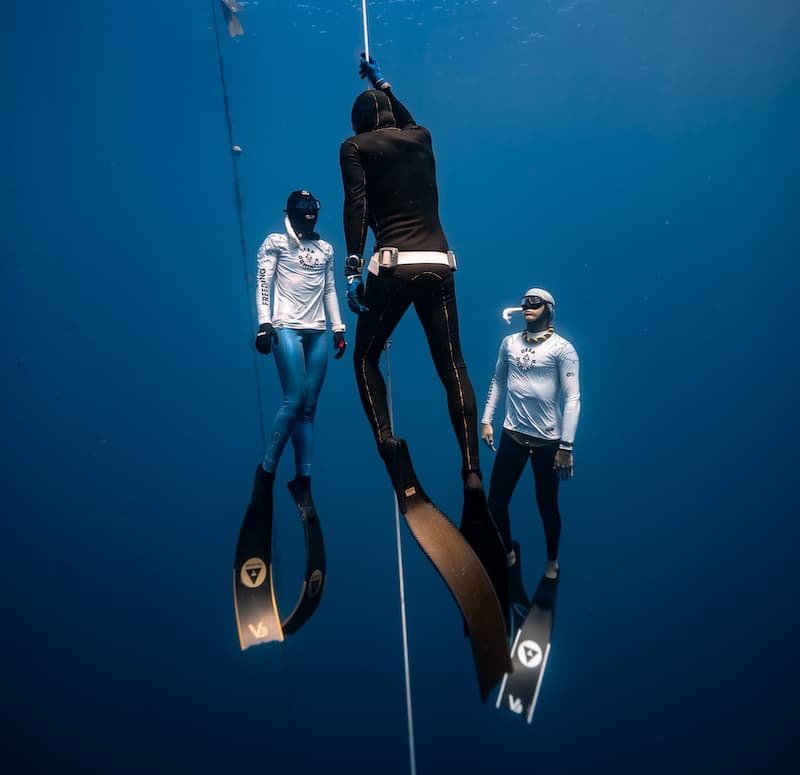
 Nick Pelios
Freediver, Creator
Nick Pelios
Freediver, Creator

 Nick Pelios
Freediver, Creator
Nick Pelios
Freediver, Creator
Freediving pushes the limits of human endurance, with athletes extremely deep on a single breath. But behind these incredible feats are the unsung heroes—safety divers—who ensure the athletes’ safety in high-stakes moments. In an article originally published in The Guardian, the critical role of these safety divers is highlighted, showing how their quick actions and expertise make the difference between life and death in the depths of the ocean. Here's a closer look at their vital work and the challenges they face.
In 2023, Gary McGrath was attempting a 95-meter dive in Sharm el-Sheikh, Egypt, when he began to struggle during his ascent. Safety divers, trained for emergencies like this, quickly noticed his movements slowing before he stopped rising altogether. Reacting immediately, they sealed his airways, grabbed his hips, and pulled him to the surface – all while holding their own breath. Without their quick actions, McGrath, who lost consciousness just 12 meters from the surface, wouldn't have survived. "I woke up and people were cradling me," McGrath recalled, reflecting on the life-saving intervention. This was the only time McGrath experienced a blackout in years of freediving, but it’s a moment he’ll never forget.

Safety divers are specially trained individuals who accompany freedivers during competitions, prepared to step in when needed. They descend alongside athletes, closely observing for signs of trouble like changes in technique or loss of consciousness. As part of a coordinated team, safety divers meet athletes at various depths – typically at 30 meters, with others joining at shallower levels and one stationed at the surface.
Their task is not just physically demanding but also mentally intense. It requires deep focus, quick decision-making, and a calm demeanor even in the most high-pressure situations. Louisa Collyns, one of the world’s leading safety divers, says that although freediving is often branded as an “extreme sport,” most participants, including safety divers, view it through a different lens. She emphasizes the calculated risks and training that go into the sport.
After the tragic incident involving freediver Alessia Zecchini and safety diver Stephen Keenan, featured in the Netflix documentary The Deepest Breath, the dangers of freediving gained global attention. Keenan lost his life during a dive in Dahab, Egypt, a chilling reminder of what can happen when something goes wrong in this high-risk sport.
However, the majority of dives end successfully, with safety divers rarely having to intervene. When they do, it’s a delicate balance of knowing when to act without prematurely disqualifying the athlete. "You’ve got to be very sure that it’s going to be a rescue because if you do it too soon or if you’re wrong, you disqualify the athlete, which is quite a responsibility,” says Collyns.
Freediving safeties are often part of tight-knit communities, such as the one in Dahab, Egypt, where many divers, both recreational and competitive, gather to train and push their limits. It was here, in Dahab’s famous Blue Hole, that I found myself working alongside 12 other safety divers, overseeing dives of up to 90 meters during the Dahab Open Championship, Mc Grath states.
Although the majority of our work involves watching athletes break records and celebrating their success, there are moments when we are reminded of the risks. During the competition, a Bahraini diver named Bassam Sabt blacked out at depth. He later expressed his gratitude, saying: “[The safeties] know what they’re doing and they are there just for us… so I feel so safe in competitions.”
Despite the challenges, there’s a deep sense of camaraderie and purpose among safety divers. The work is grueling, with repetitive dives over several hours, but the satisfaction of keeping athletes safe makes it worthwhile.

As freediving continues to evolve, with athletes regularly breaking records and pushing the boundaries of human endurance, the role of safety divers will become even more critical. According to AIDA over 100 athletes have now dived deeper than 100 meters in official competitions, and this number is expected to rise.
However, despite their vital role, many safety divers receive little financial compensation for their work. Most are driven by a passion for the sport, and the future of freediving relies not only on the athletes but also on the dedication of these remarkable individuals who risk their own safety to protect others. As McGrath says, “I’m not taking unnecessary risks, it’s all calculated. And part of that calculation is the guys up top.”